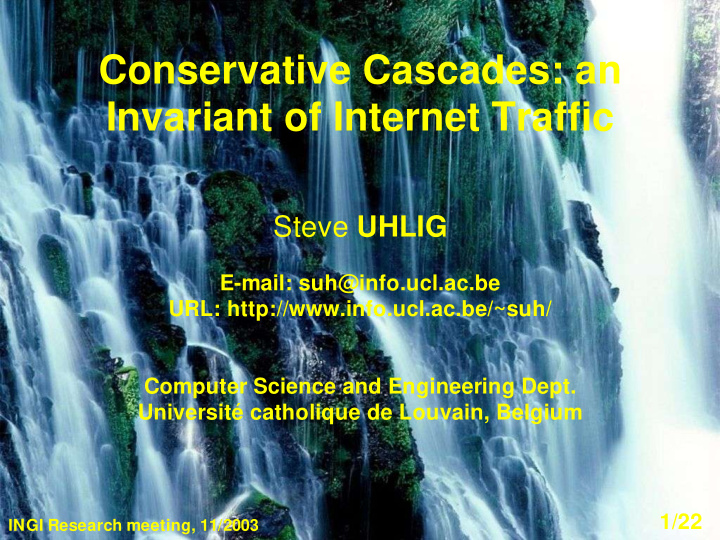



Conservative Cascades: an Invariant of Internet Traffic Steve UHLIG E-mail: suh@info.ucl.ac.be URL: http://www.info.ucl.ac.be/~suh/ Computer Science and Engineering Dept. Université catholique de Louvain, Belgium 1/22 INGI Research meeting, 11/2003
Schedule 1) Scaling theory ⇔ Scaling theory 2) Cascades and TCP traffic ⇔ Scaling practice 3) TCP traffic analysis ⇔ Traffic analysis 4) Conclusions 2/22 INGI Research meeting, 11/2003
Scaling Scaling theory ~ absence of characteristic (time)scale ~ dependence among (time)scales Many different types of scaling flavours : - self-similarity - long-range dependence - multiscaling - multifractality - infinitely divisible cascades 3/22 INGI Research meeting, 11/2003
Scaling Terminology theory Let X(t) be a regularly sampled process : - d(j,k) : process increment at timescale j and time k - q : moment of the process - j : timescale, j = 1,...,n. - E|X(t)| q : expectation of moment q of process X at time t (over all possible realizations of the process). Assumption : - d(j,k) is a homogeneous (stationary) zero-mean process. 4/22 INGI Research meeting, 11/2003
Scaling Self-similarity theory E|d(j,.)| q = C q (2 j ) qH ∝ exp(q H ln(2 j )) - linear scaling among timescales and linear scaling among moments both driven by a single parameter H ⇒ called mono-scaling since H is constant 5/22 INGI Research meeting, 11/2003
Scaling Multiscaling theory E|d(j,.)| q = C q (2 j ) H(q) ∝ exp(H(q) ln(2 j )) - linear scaling among timescales j, but driven by a function H(.) of the moment q ⇒ mono-scaling becomes multi-scaling since scaling depends on the moment q 6/22 INGI Research meeting, 11/2003
Scaling Infinitely divisible cascade theory E|d(j,.)| q = C q (2 j ) H(q) ∝ exp(H(q) n(2 j )) where H(q) represents 1 step of the cascade n(2 j ) represents cascade depth at timescale j ⇒ scaling does not depend linearly on the moment q nor the timescale j anymore 7/22 INGI Research meeting, 11/2003
Scaling The missing link theory E|d(j,.)| q ∝ exp(f(q) g(2 j )) - separability of the moments ( q ) and the timescales ( j ) - higher-order moments emphasize on larger irregularities - larger timescales focus on smoothed versions of the process (zooming out) ⇒ framework to study irregularities and timescales independently 8/22 INGI Research meeting, 11/2003
Scaling Probabilistic interlude theory - Cascade : multiplicative process that breaks a process into smaller and smaller fragments according to some (deterministic or random) rule. - Link with infinitely divisible distributions (Feller vol. 2) : F is infinitely divisible if for every n there exists a n* where “*” denotes the distribution F n such that F = F n convolution operator. or equivalently F is infinitely divisible iff for each n it can be represented as the distribution of the sum S n = X 1,n + ... + X n,n of n independent random variables with a common distribution F n . 9/22 INGI Research meeting, 11/2003
Scaling Conservative cascades theory 2 objectives : - preservation of total mass of the process - randomness in the splitting of the mass of the process Example : Step 1 : Step 2 : Step 3 : 10/22 INGI Research meeting, 11/2003
Scaling Conservative cascades practice and TCP traffic TCP : - breaks the total mass of the data to be sent into segments - application sending data, TCP state machine and random network conditions drive how data segments are broken and when they are sent over time Host A Host B Segments sent by TCP : 11/22 INGI Research meeting, 11/2003
Scaling Cascade parameters practice and TCP H(q) : - describes cascade generator (1 step of the breaking of the data) - represents how TCP distributes the mass of the TCP segments into large and small irregularities j ) : how many times the generator has been n(2 applied at timescale j (how many times the convolution operator has been applied) ⇒ H() and n() “ summarize” the numerical behavior of the cascade 12/22 INGI Research meeting, 11/2003
Scaling Wavelet analysis practice - process increments d(j,k) replaced by wavelet coefficients (j,k) - Wavelet-based partition function : S(q,j) = ∑ k |2 -j/2 ( j,k) | q ( ∝ E|d(j,k)| q ) j ) via regression : - Estimation of H(q) and n(2 ln(S(q,j)) ≅ - H(q) n(2 j ) + K q 13/22 INGI Research meeting, 11/2003
Traffic Internet traffic analysis analysis - 15 hours of IP packets from Auckland - both traffic sent to the Internet and received from the Internet - 1,629,069 incoming TCP flows, 1,613,976 outgoing - more than 13 GBytes of incoming traffic, 10 GBytes outgoing - 1 s precision, 1 ms time granularity used. 14/22 INGI Research meeting, 11/2003
Traffic Multiscaling analysis (out) analysis multi- scaling multi- scaling 15/22 INGI Research meeting, 11/2003
Traffic Multiscaling analysis (in) analysis mono- scaling multi- scaling 16/22 INGI Research meeting, 11/2003
Traffic Cascade analysis (out) analysis no cascade stationary cascade 17/22 INGI Research meeting, 11/2003
Traffic Cascade analysis (in) analysis no cascade non-stationary cascade 18/22 INGI Research meeting, 11/2003
Traffic Variance analysis (out) analysis stationary variance 19/22 INGI Research meeting, 11/2003
Traffic Variance analysis (in) analysis non-stationary variance 20/22 INGI Research meeting, 11/2003
Conclusions - Cascade model captures well invariance in TCP behavior - Cascade model does not fully capture traffic dynamics, only TCP traffic segmentation - Cascade parameters do not show effect of cross-traffic, 2 nd order properties do 21/22 INGI Research meeting, 11/2003
After-thoughts - Cascade is OK to generate clean TCP traffic at timescales below seconds - Cascade is not OK to simulate realistic Internet traffic - More work necessary to understand role of the “ abstract” cascade parameters on the traffic behavior - Can we distinguish between “ normal” and “ abnormal” TCP flows thanks to real-time monitoring of cascade parameters ? 22/22 INGI Research meeting, 11/2003
Recommend
More recommend